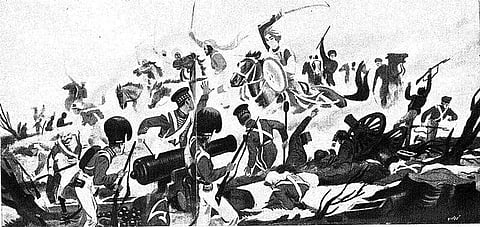
- Home
- न्यूजग्राम
- NewsGram USA
- India
- World
- Politics
- Entertainment
- Culture
- Lifestyle
- Economy
- Sports
- Sp. Coverage
- Misc.
- NewsGram Exclusive
- Jobs / Internships

The death anniversary of 'Jhansi ki Rani' or Rani Lakshmibai Balidan Divas is on June 18. Today as we remember the Queen of bravery, and one of the leading figures of the Indian Rebellion of 1857, let's look at her journey of life.
She was a couragious woman who stood for her rights and her kingdom and will forever remain etched in Indian history. She was a fearless lady who wouldn't stand down to anyone. Subhadra Kumari Chauhan, the renowned hindi poet wrote a poem of 126-lines about Lakshmibai which was titled as 'Jhansi Ki Rani'.
Rani Lakshmibai was born on 19 November 1828 in Benares (now Varanasi). In her early age she was known as Manikarnika or Manu. Her mother passed away at an early age of four and her father Morepant Tambe, then moved to Bithoor to live with his cousin, who was a former Peshwa (or prime minister) in the Maratha Empire.
Follow NewsGram on Instagram to keep yourself updated.
The above picture shows the birthplace of Rani Lakshmibai. Wikimedia Commons
Her childhood companions were 2 boys of nearly her age, Tantia Tope and Peshwa Baji Rao II's adopted son Nanasahib. She spent her childhood accompanying them in all their activities whether it's fencing or traditional gymnastics or shooting. Horse-riding happened to be her favourite among all.
Even later on, she gave her horses special names. As was the custom then, when she was in her early teens, Manu was married to Gangadhar Rao, the maharaja of Jhansi. She became Rani Lakshmibai, known in her small kingdom for her habit of riding between the palace and the temple, preferring her horses — Sarang, Badal and Pavan — to the palanquin tells Anu Kumar in their article for The Indian Express.
The British East India Company was slowly taking over more territories and kingdoms. Jhansi, which was located in the heart of India and had access to the west and north was in the sights of the Britishers.
The Maharaja of Jhansi, her husband, died in 1853 due to which British Governor General Lord Dalhousie refused to recognise the rights of Lakshmibai or her adopted son, Damodar Rao, to Jhansi. Lakshmibai decided to take action against this.
After giving a tough fight to the Britishers, Rani Lakshmibai was killed on 17 June 1988. Wikimedia Commons
Her childhood companions, Nanasahib and Tantia Tope, were already against the British Rule as they were attempting to deprive Nanasahib of his pension. A fierce resistance put up by these three friends that fuelled the fight against the British in 1857.
The uprising begun by soldiers in Barrackpore (now Barrackpur in West Bengal) became the First War of Independence against the British rulers in India. It took over a year for the British to quell it in a brutal operation, in which Lakshmibai and many others lost their lives. For her courage against the British colonizers and her martyrdom for her country, Lakshmibai continues to be a role model tells Anu Kumar in their article for The Indian Express.
